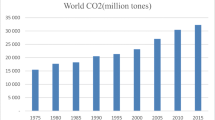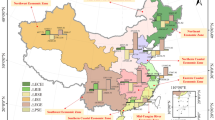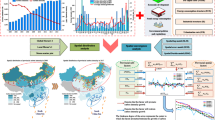Abstract
The increase in carbon emissions has had great negative impacts on the healthy developments of the human environment and economic society. However, it is unclear how specific socio-economic factors are driving carbon emissions. Based on the multiscale geographically weighted regression (MGWR) model, this paper analyzes the impact mechanism of China’s carbon emission data during 2010–2017. The results show that (1) during the study period, China’s carbon emissions have obvious positive correlations in the spatial distribution, and the spatial autocorrelation of carbon emissions on the time scale has a further strengthening trend. (2) Compared with the results of the geographically weighted regression (GWR) model, the MGWR model is more robust, and the results are more realistic and reliable. The impacts of energy intensity, proportion of green coverage in built-up areas, and industrial structure on provincial carbon emissions are close to the global scale, and their spatial heterogeneity is weak. Other factors have spatially heterogeneous impacts on carbon emissions with different scale effects. (3) Except for proportion of green coverage in built-up areas, the industrial structure and trade openness have insignificant impacts on carbon emissions, but other variables have significant impacts. The total population, urbanization rate, energy intensity, and energy structure have positive impacts on carbon emissions, while the GDP per capita and foreign direct investment have negative impacts on it. This study shows that the main socio-economic factors have different degrees of impacts on carbon emissions with different scale, and we can refer to it to formulate more scientific measures to reduce carbon emissions.


Similar content being viewed by others
Data availability
Not applicable.
References
Ang BW (1999) Is the energy intensity a less useful indicator than the carbon factor in the study of climate change? Energy Policy 27(15):943–946 4
Anselin L (2010) Local indicators of spatial association-LISA. Geogr Anal 27(2):93–115. https://doi.org/10.1111/j.1538-4632.1995.tb00338.x
Barack L, Cutler C (2004) Confusion noise from LISA capture sources. Physical Rev D 70(12):122002. https://doi.org/10.1103/PhysRevD.70.122002
Brunsdon C, Fotheringham S, Charlton M (1998) Geographically weighted regression-modelling spatial non-stationarity. J R Stat Soc Series D (The Statistician) 47(3):431–443
Chen WY (2015) The role of urban green infrastructure in offsetting carbon emissions in 35 major Chinese cities: a nationwide estimate. Cities 44(April):112–120. https://doi.org/10.1016/j.cities.2015.01.005
Cheng Z, Li L, Liu J (2017) Identifying the spatial effects and driving factors of urban PM2.5 pollution in China. Ecol Indic 82(November):61–75. https://doi.org/10.1016/j.ecolind.2017.06.043
Cheng C, Ren X, Wang Z, Cheng Y (2019) Heterogeneous impacts of renewable energy and environmental patents on CO2 emission - evidence from the BRIICS. Sci Total Environ 668(June):1328–1338. https://doi.org/10.1016/j.scitotenv.2019.02.063
Dong F, Li J, Zhang Y-J, Wang Y (2018) Drivers analysis of CO2 emissions from the perspective of carbon density: the case of Shandong Province, China. Int J Environ Res Public Health 15(8):1762. https://doi.org/10.3390/ijerph15081762
Du J, Zhang Y (2018) Does one belt one road initiative promote Chinese overseas direct investment? China Econ Rev 47(February):189–205. https://doi.org/10.1016/j.chieco.2017.05.010
Ertugrul HM, Cetin M, Seker F, Dogan E (2016) The impact of trade openness on global carbon dioxide emissions: evidence from the top ten emitters among developing countries. Ecol Indic 67(August):543–555. https://doi.org/10.1016/j.ecolind.2016.03.027
Fan F, Lei Y (2017) Factor analysis of energy-related carbon emissions: a case study of Beijing. J Clean Prod 163(October):S277–S283. https://doi.org/10.1016/j.jclepro.2015.07.094
Fu Y, Wu D, Wang Y, Wang H (2020) Facility location and capacity planning considering policy preference and uncertain demand under the one belt one road initiative. Transp Res A Policy Pract 138(August):172–186. https://doi.org/10.1016/j.tra.2020.05.012
Gherghina S, Katsanidou A (2013) Data availability in political science journals. Eur Polit Sci 12(3):333–349. https://doi.org/10.1057/eps.2013.8
Hao Y, Wu HT. 2020 The role of internet development on energy intensity in China: evidence from a spatial econometric analysis. Asian Econ Lett 1(1). https://doi.org/10.46557/001c.17194
He BJ, Zhao DX, Zhu X, Darko A, Gou ZH (2018) Promoting and implementing urban sustainability in China: an integration of sustainable initiatives at different urban scales. Habitat Int 82:83–93. https://doi.org/10.1016/j.habitatint.2018.10.001
He BJ, Zhao ZQ, Shen LD, Wang HB, Li LG (2019) An approach to examining performances of cool/hot sources in mitigating/enhancing land surface temperature under different temperature backgrounds based on landsat 8 image. Sustain Cities Soc 44:416–427. https://doi.org/10.1016/j.scs.2018.10.049
He BJ, Wang JS, Liu HM, Ulpiani G (2021) Localized synergies between heat waves and urban heat islands: implications on human thermal comfort and urban heat management. Environ Res 193:110584. https://doi.org/10.1016/j.envres.2020.110584
Henson RK (2001) Understanding internal consistency reliability estimates: a conceptual primer on coefficient alpha. Meas Eval Couns Dev 34(3):177–189. https://doi.org/10.1080/07481756.2002.12069034
Ove Hoegh, Guldberg, Jacob Daniela, and Taylor Michael. (2018). “Impacts of 1.5oC global warming on natural and human systems.” In Global Warming of 1.5 oC.
Hurvich CM, Simonoff JS, Tsai C-L (1998) Smoothing parameter selection in nonparametric regression using an improved Akaike information criterion. J R Stat Soc: Series B (Statistical Methodology) 60(2):271–293. https://doi.org/10.1111/1467-9868.00125
Jiang JJ, Klein G, Crampton SM (2000) A note on SERVQUAL reliability and validity in information system service quality measurement. Decis Sci 31(3):725–744. https://doi.org/10.1111/j.1540-5915.2000.tb00940.x
Jiang S, Zhu Y, He G, Wang Q, Yajing L (2020) Factors influencing China’s non-residential power consumption: estimation using the Kaya–LMDI Methods. Energy 201(June):117719. https://doi.org/10.1016/j.energy.2020.117719
Kais S, Sami H (2016) An econometric study of the impact of economic growth and energy use on carbon emissions: panel data evidence from fifty eight countries. Renew Sust Energ Rev 59(June):1101–1110. https://doi.org/10.1016/j.rser.2016.01.054
Lambert DM, Brown JP, Florax RJGM (2010) A two-step estimator for a spatial lag model of counts: theory, small sample performance and an application. Reg Sci Urban Econ 40(4):241–252. https://doi.org/10.1016/j.regsciurbeco.2010.04.001
Lau L-S, Choong C-K, Eng Y-K (2014) Investigation of the environmental Kuznets curve for carbon emissions in Malaysia: do foreign direct investment and trade matter? Energy Policy 68(May):490–497. https://doi.org/10.1016/j.enpol.2014.01.002
Lee JW (2013) The contribution of foreign direct investment to clean energy use, carbon emissions and economic growth. Energy Policy 55(April):483–489. https://doi.org/10.1016/j.enpol.2012.12.039
Lee S, Pollitt H, Ueta K (2012) An assessment of Japanese carbon tax reform using the E3MG econometric model. Sci World J 2012:1–9. https://doi.org/10.1100/2012/835917
Len C (2015) China’s 21st Century Maritime Silk Road Initiative, Energy Security and SLOC Access. Marit Affairs: Journal of the National Maritime Foundation of India 11(1):1–18. https://doi.org/10.1080/09733159.2015.1025535
Li YW, Wu HT, Shen KY, Hao Y, Zhang PF (2020) Is environmental pressure distributed equally in China?. Empirical evidence from provincial and industrial panel data analysis. Sci Total Environ 718:137363. https://doi.org/10.1016/j.scitotenv.2020.137363
Liddle B (2014) Impact of population, age structure, and urbanization on carbon emissions/energy consumption: evidence from macro-level, cross-country analyses. Popul Environ 35(3):286–304. https://doi.org/10.1007/s11111-013-0198-4
Ma M, Cai W, Cai W (2018) Carbon abatement in China’s commercial building sector: a bottom-up measurement model based on Kaya-LMDI Methods. Energy 165(December):350–368. https://doi.org/10.1016/j.energy.2018.09.070
Malekian F, Aliabadi FM (2012) Review of methods of organizing the content of the curriculum in the educational system, based on ICT (Information and Communication Technology) from the experts’ view. Procedia Soc Behav Sci 51:19–23. https://doi.org/10.1016/j.sbspro.2012.08.112
Ning Y, Yan Z (1994) The uneven development and spatial diffusion of Chinese central cities. Chin Geogr Sci 4(2):119–128. https://doi.org/10.1007/BF02664294
Peakall R, Ruibal M, Lindenmayer DB (2003) Spatial autocorrelation analysis offers new insights into gene flow in the Australian bush rat, Rattus fuscipes. Evolution 57(5):1182–1195. https://doi.org/10.1111/j.0014-3820.2003.tb00327.x
Ren L, Wang W, Wang J, Liu R (2015) Analysis of energy consumption and carbon emission during the urbanization of Shandong Province, China. J Clean Prod 103(September):534–541. https://doi.org/10.1016/j.jclepro.2014.08.098
Richmond AK, Kaufmann RK (2006) Is there a turning point in the relationship between income and energy use and/or carbon emissions? Ecol Econ 56(2):176–189. https://doi.org/10.1016/j.ecolecon.2005.01.011
Rose SK, Richels R, Blanford G, Rutherford T (2017) The Paris Agreement and next steps in limiting global warming. Clim Chang 142(1–2):255–270. https://doi.org/10.1007/s10584-017-1935-y
Saidi K, Hammami S (2015) The impact of CO2 emissions and economic growth on energy consumption in 58 countries. Energy Rep 1(November):62–70. https://doi.org/10.1016/j.egyr.2015.01.003
Sbia R, Shahbaz M, Hamdi H (2014) A contribution of foreign direct investment, clean energy, trade openness, carbon emissions and economic growth to energy demand in UAE. Econ Model 36(January):191–197. https://doi.org/10.1016/j.econmod.2013.09.047
Shen C, Li C, Si Y (2016) Spatio-temporal autocorrelation measures for nonstationary series: a new temporally detrended spatio-temporal Moran’s index. Phys Lett A 380(1–2):106–116. https://doi.org/10.1016/j.physleta.2015.09.039
Song J, Song Q, Dong Z, Lu Y, Luan L (2014) Study on influencing factors of carbon emissions from energy consumption of Shandong Province of China from 1995 to 2012. Sci World J 2014:1–12. https://doi.org/10.1155/2014/684796
Tian X, Bai F, Jia J, Yang L, Shi F (2019) Realizing low-carbon development in a developing and industrializing region: impacts of industrial structure change on CO2 emissions in Southwest China. J Environ Manag 233(March):728–738. https://doi.org/10.1016/j.jenvman.2018.11.078
“Trends in Global CO2 and Total Greenhouse Gas Emissions: 2019 Report.” (n.d.), 70.
Videras (2014) Exploring spatial patterns of carbon emissions in the USA: a geographically weighted regression approach Popul. Environ. 36:137–154. https://doi.org/10.1007/s11111-014-0211-6
Wang Q, Schoenberg FP, Jackson DD (2010) Standard errors of parameter estimates in the ETAS model. Bull Seismol Soc Am 100(5A):1989–2001. https://doi.org/10.1785/0120100001
Wang H, Yang Y, Keller AA, Li X, Feng S, Dong Y-n, Li F (2016) Comparative analysis of energy intensity and carbon emissions in wastewater treatment in USA, Germany, China and South Africa. Appl Energy 184(December):873–881. https://doi.org/10.1016/j.apenergy.2016.07.061
Wong DWS (1999) Geostatistics as measures of spatial segregation. Urban Geogr 20(7):635–647. https://doi.org/10.2747/0272-3638.20.7.635
Wu CB, Huang GH, Xin BG, Chen JK (2018) Scenario analysis of carbon emissions’ anti-driving effect on Qingdao’s energy structure adjustment with an optimization model, Part I: carbon emissions peak value prediction. J Clean Prod 172(January):466–474. https://doi.org/10.1016/j.jclepro.2017.10.216
Wu HT, Xu LN, Ren SR, Hao Y, Yan GY (2020) How do energy consumption and environmental regulation affect carbon emissions in China?New evidence from a dynamic threshold panel model. Resourc Policy 67:101678. https://doi.org/10.1016/j.resourpol.2020.101678
Xu B, Lin B (2017) Factors affecting CO2 emissions in China’s agriculture sector: evidence from geographically weighted regression model. Energy Policy 104(2017):404–414. https://doi.org/10.1016/j.enpol.2017.02.011
Xu Q, Dong Y-x, Yang R (2018) Urbanization impact on carbon emissions in the Pearl River Delta Region: Kuznets curve relationships. J Clean Prod 180(April):514–523. https://doi.org/10.1016/j.jclepro.2018.01.194
Yang Y, Zhao T, Wang Y, Shi Z (2015) Research on impacts of population-related factors on carbon emissions in Beijing from 1984 to 2012. Environ Impact Assess Rev 55(November):45–53. https://doi.org/10.1016/j.eiar.2015.06.007
Yang K, Yu Z, Luo Y, Zhou X, Shang C (2019) Spatial‐Temporal Variation of Lake Surface Water Temperature and Its Driving Factors in Yunnan‐Guizhou Plateau. Water Resources Research
Yang K, Yu ZY, Luo Y (2020a) Analysis on driving factors of lake surface water temperature for major lakes in Yunnan-Guizhou Plateau. Water Res 184:116018. https://doi.org/10.1016/j.watres.2020.116018
Yeh J-C, Liao C-H (2017) Impact of population and economic growth on carbon emissions in Taiwan using an analytic tool STIRPAT. Sustain Environ Res 27(1):41–48. https://doi.org/10.1016/j.serj.2016.10.001
Yu Y, Kong Q (2017) Analysis on the influencing factors of carbon emissions from energy consumption in China based on LMDI method. Nat Hazards 88(3):1691–1707. https://doi.org/10.1007/s11069-017-2941-0
Yu H, Stewart Fotheringham A, Li Z, Oshan T, Kang W, Wolf LJ (2020a) Inference in multiscale geographically weighted regression. Geogr Anal 52(1):87–106. https://doi.org/10.1111/gean.12189
Yu ZY, Yang K, Luo Y, Shang CX (2020b) Spatial-temporal process simulation and prediction of chlorophyll-a concentration in Dianchi Lake based on wavelet analysis and long-short term memory network. J Hydrol 582:124488. https://doi.org/10.1016/j.jhydrol.2019.124488
Zhan M, Li X, Sun H, Zhai J, Jiang T, Wang Y (2018) Changes in extreme maximum temperature events and population exposure in China under global warming scenarios of 1.5 and 2.0°C: analysis using the regional climate model COSMO-CLM. J Meteorol Res 32(1):99–112. https://doi.org/10.1007/s13351-018-7016-y
Zhang X, Karplus VJ, Qi T, Zhang D, He J (2016) Carbon emissions in China: how far can new efforts bend the curve? Energy Econ 54(February):388–395. https://doi.org/10.1016/j.eneco.2015.12.002
Zhang M, Chen W, Cai K, Gao X, Zhang X, Liu J, Wang Z, Li D (2019) Analysis of the spatial distribution characteristics of urban resilience and its influencing factors: a case study of 56 cities in China. Int J Environ Res Public Health 16(22):4442. https://doi.org/10.3390/ijerph16224442
Zhang GC, He BJ, Dewancker BJ (2020) The maintenance of prefabricated green roofs for preserving cooling performance: a field measurement in the subtropical city of Hangzhou, China. Sustain Cities Soc 61:102314. https://doi.org/10.1016/j.scs.2020.102314
Zhou N, Price L, Yande D, Creyts J, Khanna N, Fridley D, Lu H, Feng W, Liu X, Hasanbeigi A, Tian Z, Yang H, Bai Q, Zhu Y, Xiong H, Zhang J, Chrisman K, Agenbroad J, Ke Y, McIntosh R, Mullaney D, Stranger C, Wanless E, Wetzel D, Yee C, Franconi E (2019) A roadmap for China to peak carbon dioxide emissions and achieve a 20% share of non-fossil fuels in primary energy by 2030. Appl Energy 239(April):793–819. https://doi.org/10.1016/j.apenergy.2019.01.154
Funding
The authors would like to thank the reviewers for their expertise and valuable input. This research was funded by the Open Fund Project for the Key Laboratory of the National Bureau of Surveying and Mapping Information and Geography of China (2014NGCM03). Finally, we would like to thank all of the reviewers and the handling editor for their constructive input.
Author information
Authors and Affiliations
Contributions
All authors contributed to the study conception and design. Maomao Zhang and Ao Wang: conceptualization, methodology, data curation, resources, and writing—original draft. Shukui Tan: supervision, writing—reviewing, and provided technological guidance. Xuesong Zhang and Tianchi Chen: formal analysis and writing—review and editing. All the authors approved the final manuscript.
Corresponding author
Ethics declarations
Ethical approval
Not applicable.
Consent to participate
Not applicable.
Consent to publish
Not applicable.
Competing interests
The authors declare no competing interests.
Additional information
Responsible Editor: Ilhan Ozturk
Publisher’s note
Springer Nature remains neutral with regard to jurisdictional claims in published maps and institutional affiliations.
Rights and permissions
About this article
Cite this article
Tan, S., Zhang, M., Wang, A. et al. How do varying socio-economic driving forces affect China’s carbon emissions? New evidence from a multiscale geographically weighted regression model. Environ Sci Pollut Res 28, 41242–41254 (2021). https://doi.org/10.1007/s11356-021-13444-1
Received:
Accepted:
Published:
Issue Date:
DOI: https://doi.org/10.1007/s11356-021-13444-1




